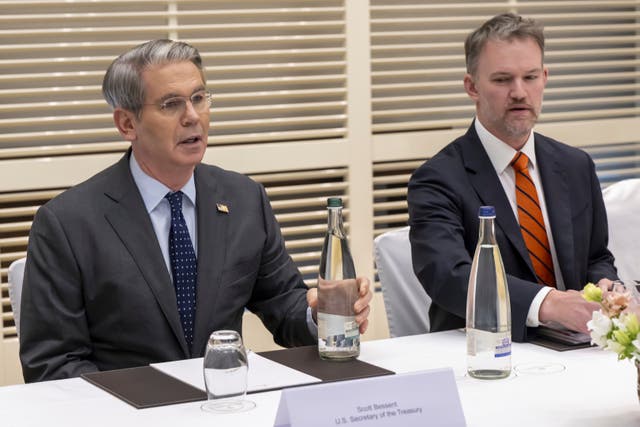Trump hails ‘great progress made’ at China tariff talks
Talks between US and China officials will continued in Switzerland on Sunday.

The first day of sensitive talks between US and Chinese delegations over tariffs ended without major breakthroughs being announced, but President Donald Trump touted “GREAT PROGRESS”.
The meeting lasted more than 10 hours in Switzerland and featured treasury secretary Scott Bessent, US trade representative Jamieson Greer and a delegation led by Chinese vice premier He Lifeng.
Hours after talks had concluded, Mr Trump took to social media to suggest a full reset of trade between the US and China could be on the table.
“A very good meeting today with China, in Switzerland. Many things discussed, much agreed to. A total reset negotiated in a friendly, but constructive, manner,” Mr Trump wrote on his Truth Social platform.
“We want to see, for the good of both China and the U.S., an opening up of China to American business. GREAT PROGRESS MADE!!!”
He gave no further details and officials at the White House offered little information during and after the opening day of discussions.
Mr Trump’s post followed an official telling The Associated Press talks would continue on Sunday. The official requested anonymity because of the sensitivity of the discussions, which could help stabilise world markets.
The talks have been shrouded in secrecy and neither side made comments to reporters on the way out.
Several convoys of black vehicles left the residence of the Swiss ambassador to the UN in Geneva, which hosted the talks.
The opening day of negotiations was held in the sumptuous 18th-century Villa Saladin overlooking Lake Geneva.

Mr Trump’s assessment aside, prospects for a major breakthrough appeared dim when the talks opened.
There is hope the two countries will scale back the massive tariffs they have slapped on each other’s goods, a move that would relieve world financial markets and companies on both sides of the Pacific Ocean, which depend on US-China trade.
Mr Trump last month raised US tariffs on China to a combined 145%. China retaliated by hitting American imports with a 125% levy.
Tariffs that high essentially amount to the countries’ boycotting each other’s products, disrupting trade that last year topped 660 billion dollars (£450 billion).
Before talks got underway, Mr Trump suggested on Friday the US could lower its tariffs on China, saying in a Truth Social post that “80% Tariff seems right! Up to Scott.″
Since returning to the White House in January, Mr Trump has aggressively used tariffs as his favourite economic weapon.
The fight with China has been the most intense. His tariffs on China include a 20% charge meant to pressure Beijing into doing more to stop the flow of the synthetic opioid fentanyl into the United States.
The remaining 125% involve a dispute that dates back to the president’s first term and comes atop tariffs he levied on China back then, which means the total tariffs on some Chinese goods can exceed 145%.
During his first term, the US alleged that China uses unfair tactics to give itself an edge in advanced technologies such as quantum computing and driverless cars.
These include forcing US and other foreign companies to hand over trade secrets in exchange for access to the Chinese market, using government money to subsidise domestic tech firms and outright theft of sensitive technologies.
Mr Trump is also agitated by America’s massive trade deficit with China, which came to 263 billion dollars (£197 billion) last year.





